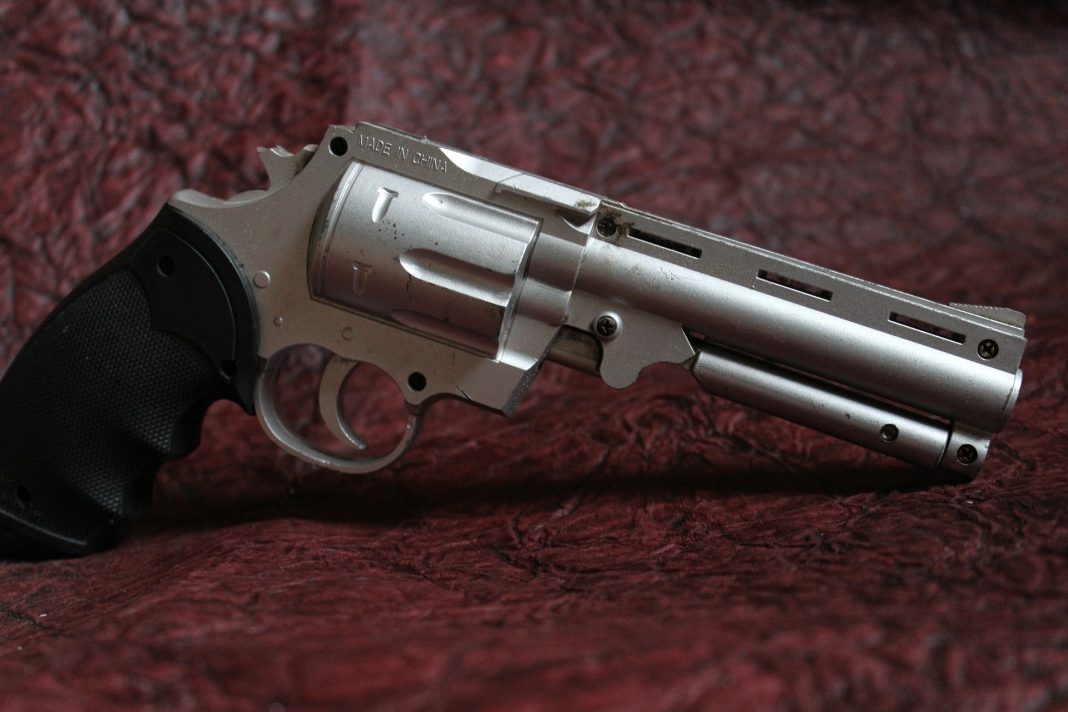 |
|
| Issue #103 • January/February, 2007 |
There are so many makes and models of firearms in existence that no one has ever counted them all. Each variation may have subtly different handling requirements. It’s incumbent upon us, the owners of those potentially lethal weapons, to know the subtleties of how they operate.
Let me tell you why I picked that for my topic this issue. In August of 2006, the following letter came in to Backwoods Home from reader Dick Rinehart:
“Mas Ayoob, one of my favorite ‘gun cranks,’ writes a superb article on the single action revolver in Issue #101. Nicely done dissertation on a century-old design that has carried over to the twenty-first century quite well, thank you. And I hate to be the one to point this out, but he made a small, but critical misstatement regarding the safe loading procedure for these interesting firearms.
“Mas carefully explains the ‘load one, skip one, load four’ sequence necessary to result in an empty chamber under the hammer to prevent negligent discharges while being carried. But he says this procedure results in the empty chamber winding up under the hammer when the last, fifth, cartridge is inserted. Not true. At this point, the first cartridge loaded is under the hammer. One must bring the hammer to full-cock, rotating the empty chamber into position under the hammer, and then carefully lower the hammer onto said empty chamber.
“I’m absolutely certain Mas knows this as well as I do. And I’m likewise certain he would want this pointed out to the perhaps less-familiar gun handlers out there.”
My first reaction to this was, “What the hell…?”
|
My second was to open my gun safe, select a single action “hawg-leg” revolver, and dig up a box of .45 Colt cartridges.
And my third reaction, after loading the gun in the usual fashion, was to mutter, “Oh, crap!”
‘Cause Dick Rinehart was right.
As I finished charging the six-gun, I watched my thumb automatically draw the hammer back from the half-cock position in which such a revolver is normally loaded, and then lower it onto the empty chamber. Retracting the hammer that part of an inch to the rear before lowering it from the full cock position is something I’ve done since I got my first single action revolvers, a first generation Colt Frontier .44-40 and an early Ruger Flat-top Blackhawk .44 Magnum, back in my mid-teens. It’s been a lot of decades since, and the lowering of the hammer by bringing it all the way back and then all the way forward had become so much second nature that I hadn’t written it down as part of the protocol in the article Mr. Rinehart mentioned.
Dick…THANK YOU!
The first thing discovering my mistake reminded me was that with a gun you’re unfamiliar with, you should ask someone who knows that particular model to SHOW YOU EXACTLY how to do it. The “showing exactly” thing was my job, and I blew it. I herewith offer my apologies.
|
The second thing it reminded me is, “check and double check.” With a Peacemaker-style single action revolver, you want to complete the loading process by attempting to turn the cylinder with your fingertips once the hammer’s down, and making sure that the cylinder is locked into position. Then, glance in through the side of the gun at the area between the back of the cylinder and the hammer’s side of the frame. You should see cartridge casing heads in five of the six chambers, and you should see the empty chamber directly beneath the hammer.
It’s not enough to just watch someone do it. You want to learn the manipulation of a new firearm first by watching someone familiar with it go through the “manual of arms,” and THEN, under that person’s supervision, doing it yourself until you’ve got it down pat.
I recall a fellow who shot himself on the foot at a public shooting range in Miami. He was shooting a Taurus PT92, which was a variation of the Beretta 92 semiautomatic 9mm pistol produced by Taurus of Brazil. His was an early model, which had a frame-mounted lever that served only as a dedicated manual safety. To put the gun into double action mode, the shooter had to lower the hammer by hand.
Next to him on the public firing line was a fellow with a genuine, late model Beretta 92, which to the non-gun-savvy eye looks just like its Taurus clone, and can even fool experts at a distance. However, all but the very first models of the Italian Beretta 92 have a manual safety lever that is mounted on the slide instead of the frame, which also serves as a de-cocking lever that lowers the hammer to double action mode automatically. (On G-series Berettas, that lever functions only as a de-cocker.)
The shooter with the older Taurus decided that the shooter next to him with the new Beretta had the same gun he did, and he asked him how he lowered the hammer so quickly and efficiently. The shooter obliged, thumbing the de-cock lever in a quick flicker of movement. It appeared to the new shooter that one simply thumbed the lever down and pulled the trigger to lower the hammer, which would now somehow magically be safe.
He thumbed HIS lever down, which on HIS pistol put the manual safety in the “fire” position, and pulled the trigger. Unfortunately, he also brought the gun’s muzzle down perpendicular to the ground as he did so.
|
“BANG!”
With the safety off and the trigger pulled, the pistol naturally did what it was designed to do and discharged, sending a 9mm bullet through his foot and into the pavement beneath. There was much shouting and one-legged hopping and blood spatter. Fortunately, the injury was not as serious as it could have been.
Taurus later modified its 92 series to include a de-cocking function that operated off the safety lever, though that lever was still mounted on the frame as opposed to on the side of the modern Beretta. To this day, as much as the two pistols resemble one another, “safe” is UP and “fire” is DOWN on the Taurus’ frame-mounted lever, while “safe” is DOWN and “fire” is UP on the lever mounted on the slide of a modern Beretta of the same “style.”
Is a given manipulation needed at all?
As a kid, my first deer rifle was a Winchester Model 94. My second was a Marlin Model 336. Both were lever action rifles with exposed hammers, and I carried each of them the same way. The tubular magazine under the barrel was fully loaded, there was a live cartridge in the firing chamber, and the hammer was down in a half-cock position.
Lowering that hammer on the live round was tricky. Lots of folks had stories of accidental discharges when the hammer slipped out from under a tired or careless thumb and snapped forward, firing the chambered cartridge. Because country people are generally smart enough to never point firearms at anything they are not prepared to destroy, most of these accidents caused nothing worse than a bad and sobering scare.
As a youngster, I was taught to take my finger off the trigger as soon as the hammer it had released had begun to move forward. This made it more likely that if the thumb slipped and the hammer “got away,” it would land harmlessly on the half-cock notcha safety designed into the gun for just such a purposeinstead of hitting the firing pin and discharging the rifle.
Yet, over the years, there were reports of other problems. The early design Winchester ’94 in particular had a heavy firing pin, and if the gun was dropped or struck on either butt or muzzle, the firing pin could bounce forward in its internal channel hard enough to “inertia-fire” a chambered round. The manufacturers dealt with this in the late 20th century in several ways that purists disliked: Lighter firing pins, stronger firing pin springs, cross-bolt safeties, even at one point a tang safety like a double barrel shotgun’s.
|
However, shooters adapted differently. More than ever, they went with the old Frontiersman’s approach to the lever action rifle and simply carried it with the chamber empty, levering a round into the launch tube as they brought the rifle to the shoulder and took aim at their quarry.
This, in the long run, is probably the best approach with this type of firearm. The lever action rifle is a staple in Western style cowboy action shooting matches, such as those sponsored by SASS, the Single Action Shooting Society. In all SASS stages, the lever action rifle begins with its magazine loaded, but its chamber empty. The shooter cannot jack the lever and cycle a cartridge into the chamber until the “start” signal has “set him to shootin’.”
Stay with safe habits
One gun of a certain type might be safe to carry with a round in the chamber, and another, not. Let’s go back to the single action revolvers we discussed at the beginning of this column. Cap ‘n ball single action revolvers go back to the year 1836, when Samuel Colt patented his first model, the Paterson. All through the years of the Wild West it was understood that the gun should NEVER be carried with a live load under the hammer.
One who learned this the hard way was none other than the legendary Wyatt Earp. The Wichita (Kansas) Beacon newspaper reported in its January 12, 1876 edition, “Last Sunday night, while policeman Earp was sitting with two or three others in the back room of the Custom House Saloon, his revolver slipped from his holster, and falling to the floor, the hammer which was resting on the cap, is supposed to have struck the chair, causing a discharge of one of the (chambers). The ball passed through his coat, struck the north wall then glanced off and passed out through the ceiling. It was a narrow escape and the occurrence got up a lively stampede from the room. One of the demoralized was under the impression that someone had fired through the window from the outside.”
Today, of course, we have modern revolvers with frontier styling that can be fully loaded with a live round under the hammer, in perfect safety. This is because an updated mechanism, usually involving a transfer bar, requires a pull of the trigger to fire the gun.
However, most of us in the “gun biz” still carry all our single action revolvers with empty chambers under the hammers and recommend that our readers, students, and customers do the same. The reason is simple: A habit you get into with one gun will transfer to another one. If you get into the habit of carrying your modern Ruger New Model single action with a round under the firing pin, you’ll find yourself doing the same if the day comes that you carry an old Colt Single Action Army. It’s safe with the new style Ruger. It’s NOT safe with the old style Ruger or the Single Action Army. If you simply keep the chamber under the hammer empty with all single action revolvers, you’ve covered all the bases.
A similar rule is in place with semiautomatic pistols. The modern designs created for law enforcement and military use, such as the Beretta, the Heckler and Koch, the Ruger, the SIG-Sauer, the Smith & Wesson, the Springfield XD, and some others, were designed and intended to be carried with a live round “up the spout.” If struck anywhere, dropped, etc., they will not discharge so long as they have been de-cocked in accordance with the manufacturer’s instructions in the owner’s manual.
|
However, there are a great many pistols for which that is not true. The first generation Smith & Wesson autoloaders, produced roughly from 1954 to 1980, theoretically can discharge if dropped hard enough with a live round in the chamber, unless the manual safety is engaged. There are several inexpensive pistols such as the Lorcin and the Raven, to name but two, floating around out there that do not have secure firing pin designs and can discharge from impact if struck or dropped. These should NEVER be carried with live rounds in the chamber. If one must use such a pistol, load only the magazine, and rack the slide to bring a cartridge into the chamber only when you perceive an immediate need to actually fire.
There are also a great many derringer pistols of the old Remington 19th century pattern that are known to go off when dropped. In my opinion, such handguns are curiosities and conversation pieces and should not be carried loaded at all.
More modern hunting guns
The slide action shotgun is one of the most classic backwoods home firearms. It is customary to chamber a round and put the gun “on safe” when actually hunting with it. Problems rarely occur with this. However, I would strongly advise that the gun never be stored with a live shell in the chamber. The reason is that these guns are at least theoretically capable of firing if struck hard enough on either end. Once again, it is firing pin movement and “inertia discharge” that’s at fault.
You would think that if anyone needed a shell in the chamber of their shotgun all the time, it would be a working police officer who can face a life or death gunfight at any moment. Yet, though the repeating shotgun was a standard law enforcement weapon throughout the 20th century and remains so today, you will never find a police department that authorizes carrying one in the patrol car with a chambered shell.
If the patrol car should hit something head on or be rear-ended, a shotgun in the trunk, whose muzzle has worked its way forward, can “impact fire” through the back seat and into the passenger compartment. If the gun is stored transversely, in a roof lock or along the front seat, the same thing can happen if the car is T-boned. Many patrol cars still have a carry system that used to be more common, with the gun racked vertically in plain sight in a lock attached to the dashboard, holding it muzzle up. The chamber will still be empty, because if in a high speed pursuit the vehicle crests too steep a hill or goes over a sidewalk and goes airborne, when it comes down it can hit with enough impact to bounce the firing pin upward toward the primer, with sufficient force to discharge a shell in the chamber.
Learn from the cops. If you carry a long gun loaded in your farm vehicle, load the magazine only and leave the chamber empty until it’s actually time to shoot. This is even true of most bolt action sporting and target rifles.
Trigger finger placement
The hunter generally stalks with gun in hand, at least when there is reason to believe the game is close. The safety catch should be “on safe,” or the hammer down on the safety notch, until it’s actually time to shoot. In all cases, the trigger finger should not be anywhere near the trigger until that same moment.
|
The late Col. Jeff Cooper created the Four Rules which among many have superseded the old “Ten Commandments of Firearms Safety.” The four rules are:
I. Every gun is always loaded. (That may or may not be the case, but what the Colonel meant was, to treat every gun as if it was fully loaded.)
II. Never allow the gun to point at something you are not prepared to destroy.
III. Never let the trigger finger enter the trigger guard until you are ready to fire.
IV. Always be sure of your target and what is beyond it.
As to Rule III, I’ve seen a lot of folks misinterpret that as “on target, on trigger; off target, off trigger.” That’s good enough for the firing range, but not for all practical uses. In the boondocks, you may well have to take a dangerous human being at gunpoint. If you do so, you’re consciously and subconsciously “on target,” but if you go “on trigger,” any bump, startle response, loss of balance, etc., can cause your index finger to accidentally close and fire your weapon into a human being who has already surrendered to you. Such an unnecessary death can leave you emotionally devastated, financially impoverished, and physically imprisoned.
Rule III should be interpreted as, “never let your finger be in the trigger guard UNLESS YOU ARE IN THE VERY ACT OF INTENTIONALLY FIRING THE WEAPON.”
However, if the finger is kept straight on the front of the trigger guard, it can be held taut, setting the stage for it to snap back against the trigger with enough impact to discharge the gun if the shooter is startled. The same is also possible with the finger straight along the frame. I’ve personally come to believe that the safest position is with the trigger finger crooked, and its tip resting on the frame above the trigger area. This way, even if the hand is somehow caused to convulse and the index finger snaps into the guard, it comes across the trigger instead of straight back into it, greatly reducing the likelihood of an accidental discharge. In all my decades of shooting and teaching and researching gun matters, I’ve never found a case of an accidental discharge when the gun was held in this manner.
Let me conclude by thanking Dick Rinehart one more time for catching that slip. Lethal weapons are singularly unforgiving entities. It’s the little things about them that can getcha.




















